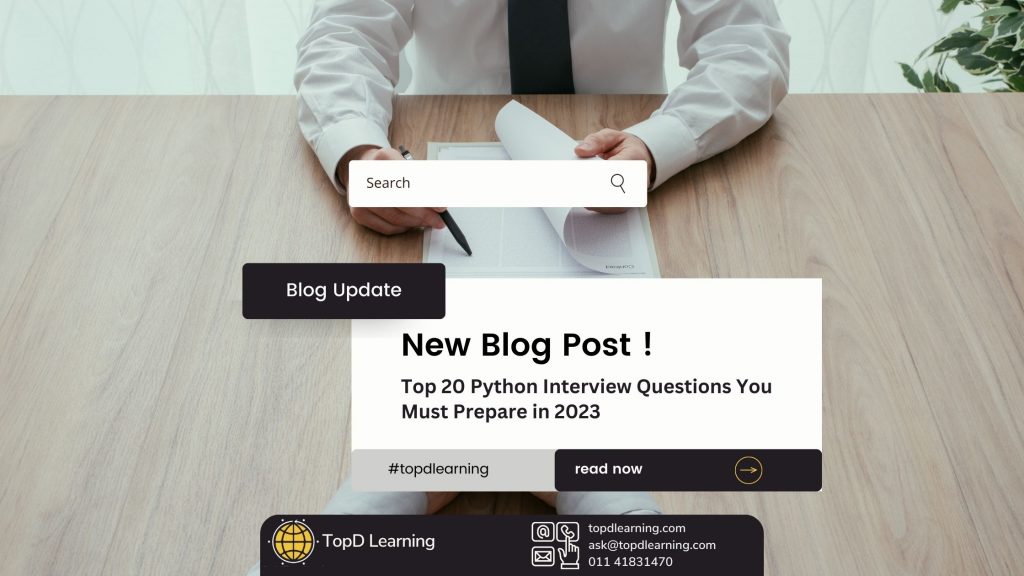Get ready to ace your Python interview with our detailed guide to the top 20 Python interview questions. Learn, understand, and apply – your path to Python success starts here.
Hello, Python enthusiasts! If you’re preparing for a Python job interview, you’ve come to the right place. At TopD Learning, we’re committed to helping you shine in your interviews. So, let’s embark on this journey together!
Introduction
Python continues to be a leading language in the world of programming, data science, machine learning, and web development. As a result, Python proficiency is a highly sought-after skill in the tech industry. To help you prepare for your next Python job interview, we’ve compiled a list of the top 20 Python interview questions you should know. Each question is accompanied by a detailed explanation to help you fully grasp the concept. Let’s dive in!
The Top 20 Python Interview Questions
1. Explain the difference between a list and a tuple in Python.
Lists and tuples are both sequence types that can store a collection of items. The key difference is that lists are mutable (they can be changed), while tuples are immutable (they cannot be changed). This makes tuples ideal for storing data that should not be modified, while lists are perfect for data that needs to be manipulated.
2. How does Python handle memory management?
Python handles memory management using a private heap space. All Python objects and data structures are located in this private heap. The Python memory manager manages this heap and ensures its efficient use. This automatic memory management can help you avoid common programming errors and memory leaks.
3. What is the Global Interpreter Lock (GIL) in Python?
The Global Interpreter Lock (GIL) is a mechanism used in the CPython interpreter to synchronize the execution of threads so that only one native thread executes Python bytecode at a time. This lock is necessary because CPython’s memory management is not thread-safe. Understanding the GIL is crucial when working with multi-threading in Python.
4. What are decorators in Python and how would you use them?
Decorators in Python are a powerful tool that allow us to wrap another function to extend the behavior of the wrapped function, without permanently modifying it. They are used for metaprogramming and can be used to modify the behavior of class methods and functions, or to monitor the execution of functions and methods.
5. Can you explain the use of *args and **kwargs in Python?
*args and **kwargs are special syntax in Python for passing a variable number of arguments to a function. *args is used to send a non-keyworded variable-length argument list, and **kwargs is used to send a keyworded variable-length argument list. They are commonly used in function definitions where the number of arguments is unknown or can vary.
6. What is the difference between “is” and “==” in Python?
The == operator compares the values of both the operands and checks for value equality, while is checks whether both the operands refer to the same object in memory. This is a subtle yet important distinction in Python and understanding the difference can help you avoid common mistakes.
7. How does exception handling in Python work?
Exception handling in Python is done through the use of three keywords: try, except, and finally. The try block contains the code segment that might throw an exception, the except block contains the code that will execute if an exception occurs, and the finally block contains the code segment that will always execute, regardless ofwhether an exception occurred. Exception handling is crucial for writing robust code that can handle unexpected events gracefully.
8. What is the purpose of the __init__ method in Python?
The __init__ method in Python is a special method that gets called when an object is instantiated. This method is used to initialize the attributes of an object. Understanding __init__ is fundamental to working with classes in Python.
9. What is a metaclass in Python?
A metaclass in Python is the class of a class; a class is an instance of a metaclass. While Python classes are objects, metaclasses are what create these objects. They are best used for creating APIs or frameworks where we need to create classes with similar attributes and methods.
10. What is the difference between deep and shallow copy in Python?
Shallow copy creates a new object which stores the reference of the original elements. So, a change in the original element like changing the value of a list item reflects in the copied list. On the other hand, a deep copy creates a new object and recursively adds the copies of nested objects present in the original elements. Hence, changes in the original element do not reflect in the deep copy.
11. How would you implement caching in Python?
Caching can be implemented in Python using the functools.lru_cache decorator, which allows us to store the results of function calls in a cache, so that future calls with the same arguments can retrieve the stored result instead of recalculating it. Caching can significantly speed up your code by avoiding unnecessary computations.
12. What is the difference between a Python module and a Python package?
A module is a single file (or files) that are imported under one import and used. A package is a collection of modules in directories that give a package hierarchy. Understanding the difference between modules and packages will help you structure your code better.
13. What is the use of generators in Python?
Generators are a type of iterable, like lists or tuples. They do not allow indexing but they can still be iterated through with for loops. They are created using functions and the yield statement. Generators are a great way to write more efficient Python code, especially when dealing with large data that you don’t want to store in memory all at once.
14. How does Python’s garbage collection work?
Python’s garbage collector works by counting the number of references to an object. When an object’s reference count drops to zero, it is garbage collected. But for objects that reference each other, Python uses a module called gc which looks for such circular references and deletes them as well. Understanding garbage collection can help you manage memory more effectively.
15. What are Python’s built-in data types?
Python’s built-in data types are numerics (like int, float, complex), sequences (like list, tuple, range), mappings (like dict), classes, instances, exceptions, and others (like set, frozenset, bool). Familiarize yourself with Python’s built-in data types and their properties and methods.
16. What is the difference between a function and a method in Python?
A function is a block of code to carry out a specific task, will contain its own scope, and is called by name. All methods are functions, but not all functions are methods. A method in Python is somewhat similar to a function, except it is associated with object/classes. Understanding the difference between functions and methods is crucial for object-oriented programming in Python.
17. What are Python’s rules for lexical scoping?
In Python, variables thatare defined inside a function body have a local scope, and those defined outside have a global scope. This means that local variables can be accessed only inside the function in which they are declared, whereas global variables can be accessed throughout the program body by all functions. Understanding scoping rules can help you avoid common mistakes and bugs in your code.
18. What is the purpose of Python’s built-in function enumerate()?
The enumerate() function adds a counter to an iterable and returns it as an enumerate object. This enumerate object can then be used directly in for loops or be converted into a list of tuples using the list() method. The enumerate() function is very handy when you need to have access to the index of each element in the iterable while iterating over it.
19. How would you handle large datasets in Python?
Large datasets can be handled in Python using libraries like Pandas, NumPy, and SciPy. We can also use generators that allow us to iterate over large datasets without loading the entire dataset into memory. If you’re interested in data science or machine learning, handling large datasets is a key skill.
20. What are the key differences between Python 2 and Python 3?
Python 2 and Python 3 have several differences, some of the key ones being print function syntax, integer division, Unicode representation, error handling, and the range() function. Even though Python 2 is no longer maintained, some legacy codebases still use it. It’s good to know the key differences between Python 2 and Python 3.
Conclusion
Remember, the key to acing these questions is practice. Try to write code snippets for each of these topics to understand them better. And don’t forget, learning is a journey, not a destination. Keep exploring, keep coding, and keep improving. You’re well on your way to acing your Python interview in 2023!
You can get comprehensive mastery on all these topics and more in TopD Learning’s Python Training Course, which is specially curated to get best results.


